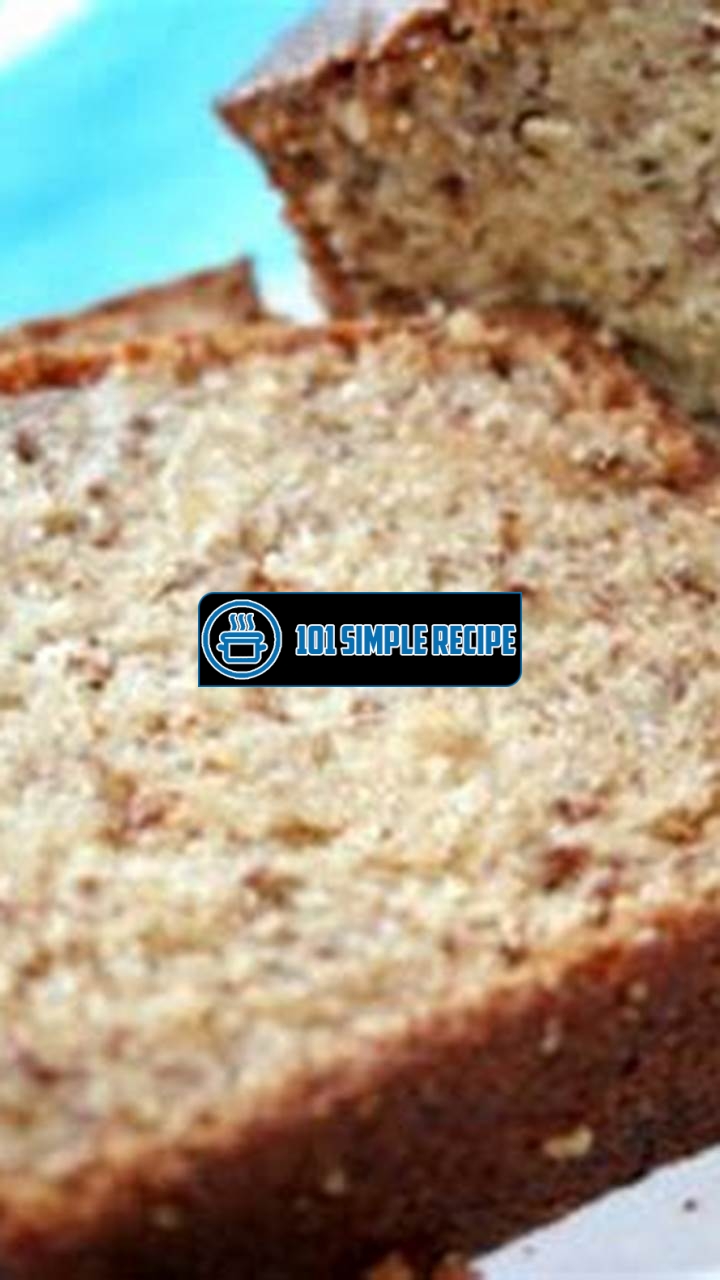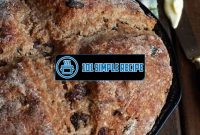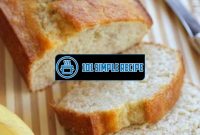If you’re craving a delicious and easy treat, look no further than this banana nut bread recipe with oil. This classic recipe combines the rich flavors of ripe bananas and crunchy nuts, creating a mouthwatering combination that’s sure to satisfy your taste buds. Not only is this recipe incredibly simple to make, but it also uses oil instead of butter, making it a healthier option without compromising on taste. Whether you’re a seasoned baker or just starting out in the kitchen, this recipe is perfect for you. So grab your ingredients and get ready to bake up a loaf of this delectable banana nut bread.

Understanding the Role of Oil in Baking
Discover the importance of using oil in banana nut bread recipes and how it affects the final product.
The Benefits of Using Oil in Baking
When it comes to baking banana nut bread, using oil as an ingredient offers numerous benefits that can enhance the overall texture and taste of your baked goods.
One of the key advantages of using oil in baking is its ability to provide moisture. Unlike butter or margarine, which may solidify as the bread cools, oil stays in a liquid state and helps maintain a moist and tender crumb. The presence of oil also helps to extend the shelf life of your banana nut bread, preventing it from becoming dry and stale too quickly. ️
In addition to moisture, oil adds rich flavor to your banana nut bread. The type of oil you choose can significantly impact the taste profile of your baked goods. For example, using a neutral-tasting oil such as vegetable or canola oil allows the flavors of the bananas and nuts to shine through. On the other hand, opting for a more flavorful oil, like walnut or coconut oil, can add a unique twist to your recipe.
Different Types of Oil for Baking
When selecting oil for your banana nut bread recipe, it’s important to consider the smoke point and flavor of the oil. The smoke point refers to the temperature at which the oil begins to smoke and break down, affecting both its taste and nutritional value. While many oils can be used for baking, some popular options include:
- Vegetable Oil: This neutral-tasting oil works well in most banana nut bread recipes, allowing the other flavors to shine through. It has a high smoke point, making it suitable for baking at higher temperatures.
- Canola Oil: Similar to vegetable oil, canola oil is another versatile option with a mild flavor. It is lower in saturated fat and has a higher omega-3 fatty acid content compared to other oils.
- Olive Oil: For a more distinct flavor, consider using extra virgin olive oil in your banana nut bread. It adds a subtle fruity taste and has the added benefits of being rich in antioxidants and heart-healthy monounsaturated fats.
- Coconut Oil: Known for its unique tropical flavor, coconut oil can lend a delightful aroma and taste to your bread. However, keep in mind that coconut oil solidifies at cooler temperatures, so it may affect the texture of your final product.
How Oil Affects the Texture and Moisture of Banana Nut Bread
The inclusion of oil in your banana nut bread recipe has a significant impact on both its texture and moisture content. The presence of oil results in a tender and moist crumb, ensuring a delightful eating experience.
When oil is mixed with the other ingredients, it helps to coat the flour particles, creating a barrier that prevents the formation of gluten. This leads to a softer and more tender texture in the finished product. Additionally, oil contributes to a better rise in the bread, resulting in a lighter and fluffier loaf.
The amount of oil used in the recipe can also affect the bread’s moisture level. Depending on personal preference, you can adjust the quantity of oil to achieve your desired level of moistness. However, be cautious not to add too much oil, as it may lead to a greasy or heavy texture in the bread.
In conclusion, the addition of oil in banana nut bread recipes plays a crucial role in enhancing the texture, moisture, and overall taste of the final product. By understanding the benefits of using oil, exploring different types of oil, and recognizing how it affects the texture and moisture of your bread, you can create a delectable treat that is sure to impress friends and family alike. Happy baking!
If you’re looking for more easy dessert recipes, try making this tasty peanut butter cups recipe at home. It’s simple and satisfying!
Choosing the Right Bananas for Your Bread
When it comes to making a delicious banana nut bread, selecting the right bananas is crucial. The ripeness and quality of the bananas can greatly impact the final result. So, let’s dive into the details and learn about the ideal bananas for your bread.
The Perfect Ripeness for Banana Nut Bread
The perfect ripeness of bananas for banana nut bread lies in the sweet spot between underripeness and overripeness. You want the bananas to be fully ripe, which means they should have a vibrant yellow color with a few brown spots scattered across the peel. This is when the bananas are at their sweetest and have the best flavor for baking.
Avoid using unripe green bananas as they lack the natural sweetness required for a flavorful banana nut bread. On the other hand, overripe bananas with an all-brown peel might result in a dense and mushy bread. It’s important to strike the right balance.
Tips for Selecting the Best Bananas at the Store
When you head to the store to buy bananas for your bread, keep these tips in mind:
- Look for ripe bananas with yellow skin and a few brown spots. These are the ideal ones for baking.
- Avoid bananas that are completely green or have a mostly brown peel. They are either too unripe or overripe.
- Gently squeeze the bananas to check for firmness. They should have a slight give without being too mushy.
- Inspect the stem area for any mold or unusual discoloration. Choose bananas that are free from bruises or damage.
Following these tips will help you choose the best bananas that are just right for your banana nut bread.
Alternative Banana Options for Your Bread
Did you know that there are other banana options you can explore for your bread? Here are a few alternatives:
Plantains: If you want to add a unique twist to your banana nut bread, try using ripe plantains instead of regular bananas. Plantains have a slightly different flavor profile and can add a delicious tropical touch to your bread.
Banana Puree: Another option is to use banana puree if you don’t have any fresh bananas available. Simply mash ripe bananas until smooth and use the puree in the same measurements as fresh bananas in your recipe.
Frozen Bananas: Don’t let overripe bananas go to waste! Peel them, place them in a freezer-safe bag, and freeze them. You can then thaw and use these frozen bananas for your bread. Freezing actually intensifies the banana flavor, making them perfect for baking.
Feel free to experiment with these alternative banana options to create a unique and delicious banana nut bread that suits your taste preferences.
Enhancing the Flavor of Your Banana Nut Bread
When it comes to banana nut bread, the possibilities are endless. With the right ingredients and flavor combinations, you can take your classic recipe to a whole new level. In this article, we’ll explore some secret ingredients and flavor variations that will enhance the taste of your banana nut bread. Get ready to elevate your baking game!
Adding Nuts and Seeds for Extra Crunch
If you love a good crunch in your banana nut bread, adding nuts and seeds is the way to go. Not only do they provide a delightful texture, but they also add extra flavor and nutrition. Here are a few options to consider:
- Walnuts: Walnuts are a classic choice for banana nut bread. They have a rich, buttery taste that complements the sweetness of the bananas.
- Pecans: Pecans add a slightly sweet and earthy flavor to your bread. They also provide a nice crunch.
- Almonds: Almonds offer a subtle nuttiness and a pleasant crunch. You can use sliced almonds or chop them up for an even texture.
- Chia Seeds: For a healthier twist, add chia seeds to your banana nut bread. They are packed with omega-3 fatty acids, fiber, and antioxidants.
Feel free to experiment with different combinations or even add a variety of nuts and seeds for a more complex flavor profile. Remember, there’s no right or wrong when it comes to customization!
Exploring Flavorful Spice Additions
Spices are the secret to adding depth and warmth to your banana nut bread. They can transform a simple recipe into a delicious masterpiece. Here are some flavorful spice options to consider:
- Cinnamon: Cinnamon is a classic spice that pairs perfectly with bananas. Its warm and comforting flavor will make your bread taste cozy and inviting.
- Nutmeg: Nutmeg has a slightly sweet and nutty taste, making it an excellent choice for enhancing the flavor of your banana nut bread.
- Allspice: Allspice is a unique spice that resembles a combination of cinnamon, nutmeg, and cloves. It adds a complex and aromatic flavor to your bread.
- Ginger: Ginger offers a slightly spicy and refreshing taste. It pairs well with the natural sweetness of bananas and adds a delightful kick to your bread.
Don’t be afraid to experiment with different amounts of spices to find your perfect balance. Remember to start with small quantities and adjust according to your taste preferences.
Creative Twists on Traditional Banana Nut Bread
If you want to go beyond the classic recipe, there are plenty of creative twists you can try to make your banana nut bread truly unique. Here are a few ideas to get you started:
- Chocolate Swirl: Add some excitement to your banana nut bread by swirling in melted chocolate or adding chocolate chips to the batter. The combination of chocolate and bananas is a match made in heaven.
- Coconut Paradise: For a tropical twist, incorporate shredded coconut into your bread. It will add a subtle sweetness and a hint of paradise to every bite.
- Orange Zest: Grate some orange zest into your batter for a refreshing and citrusy flavor. The zest will brighten up your bread and add a delightful aroma.
- Caramel Drizzle: Take your banana nut bread to the next level by drizzling some homemade caramel sauce on top. The gooey and sweet caramel will bring a touch of decadence to your creation.
Don’t limit yourself to these suggestions. Let your imagination run wild and experiment with different flavor combinations and toppings to create your signature banana nut bread.
By enhancing the flavor of your banana nut bread with secret ingredients, nuts and seeds, flavorful spices, and creative twists, you can turn a simple recipe into a truly delectable treat. Whether you’re a seasoned baker or just starting, these tips and ideas will surely take your banana nut bread to the next level. So, don’t be afraid to get creative and enjoy the delicious results!
For a refreshing drink to accompany your banana nut bread, try this pink drink recipe. It’s a fruity and colorful beverage that’s perfect for any occasion.
Mastering the Technique of Mixing and Baking
Creating a perfectly moist and well-baked banana nut bread doesn’t have to be a difficult task. With a few simple techniques and the right ingredients, you can achieve delicious results every time. Let’s dive into the step-by-step process of mastering the technique of mixing and baking this delectable treat.
How to Properly Mash Bananas for the Batter
One of the key elements in creating a flavorful banana nut bread is using ripe bananas. The riper the bananas, the sweeter the bread will be. To properly mash the bananas, start by peeling them and placing them in a bowl. Then, using a fork or a potato masher, gently mash the bananas until they reach a smooth and creamy consistency.
Important: Make sure your bananas are ripe enough to mash easily. A ripe banana will have a vibrant yellow skin with brown spots, indicating that it is at its peak sweetness and flavor.
Tips for Achieving a Smooth and Homogeneous Batter
When it comes to mixing the batter for your banana nut bread, it’s important to achieve a smooth and homogeneous texture. This ensures that all the ingredients are evenly incorporated, resulting in a loaf that is moist and flavorful throughout.
Here are a few tips to help you achieve a smooth batter:
- Add your wet ingredients first: Start by combining the oil, eggs, and mashed bananas in a large mixing bowl. Mix these ingredients together until they are well combined.
- Gradually add the dry ingredients: In a separate bowl, whisk together the flour, baking soda, salt, and any other dry ingredients specified in your recipe. Slowly add the dry mixture to the wet ingredients, stirring gently. Avoid overmixing, as this can lead to a tough and dense loaf.
- Fold in the nuts: Once the batter is well mixed, fold in the chopped nuts using a spatula. Be careful not to overmix, as this can cause the nuts to break down and lose their texture.
The Art of Baking Time and Temperature
Now that your batter is ready, it’s time to bake your banana nut bread to perfection. The baking time and temperature can vary depending on your oven and the size of your loaf pan, so it’s important to keep a close eye on your bread as it bakes.
Important: Always preheat your oven to the specified temperature in your recipe. This ensures that the bread bakes evenly and thoroughly.
As a general guideline, most banana nut bread recipes call for baking the loaf at 350°F (175°C) for about 50-60 minutes. However, it’s best to start checking for doneness around the 45-minute mark by inserting a toothpick into the center of the loaf. If it comes out clean or with a few moist crumbs clinging to it, your bread is ready.
Pro Tip: To prevent the top of your bread from browning too quickly, you can tent it with aluminum foil halfway through the baking time. This will help the bread bake evenly and maintain a moist interior.
Mastering the art of mixing and baking banana nut bread is a rewarding endeavor. By properly mashing your bananas, achieving a smooth batter, and baking it to perfection, you can indulge in a moist and flavorful treat that is perfect for any occasion.
For another delicious recipe using bananas, check out this garlic bread stick recipe. It’s a great side dish to enjoy with your banana nut bread!
Storage Tips to Keep Your Banana Nut Bread Fresh
When it comes to enjoying your homemade banana nut bread, proper storage is key. By following the best practices for storing and preserving your bread, you can ensure its freshness and deliciousness for a longer period. Whether you plan to enjoy it at breakfast or as an afternoon snack, these storage tips will help you make the most of your banana nut bread.
The Ideal Storage Conditions for Your Bread
In order to maintain the freshness of your banana nut bread, it is important to store it properly. The ideal storage conditions include keeping it at room temperature in a cool, dry place. Avoid exposing it to direct sunlight or any sources of heat, as it can cause the bread to spoil or become stale.
Pro Tip: Wrap your banana nut bread tightly in plastic wrap or aluminum foil before storing it. This will help to retain its moisture and prevent it from drying out.
Additionally, you can opt to store your bread in an airtight container or a resealable plastic bag. This will further help to protect it from moisture and keep it fresh for a longer duration. Remember to cool the bread completely before storing it to avoid condensation, which can lead to sogginess.
Freezing Techniques for Long-Term Preservation
If you want to extend the shelf life of your banana nut bread, freezing it is a great option. Freezing not only preserves the freshness but also allows you to enjoy your bread even weeks or months later.
Pro Tip: Before freezing your banana nut bread, make sure it is completely cool. Slice the bread and wrap each slice individually in plastic wrap or aluminum foil. Place the wrapped slices in a freezer-safe bag and remove any excess air before sealing.
When you are ready to enjoy your frozen bread, simply remove the desired number of slices from the freezer and let them thaw at room temperature. You can also reheat the slices in a toaster or microwave for a warm, freshly baked taste.
Reviving Stale Banana Nut Bread
Even if your banana nut bread has gone slightly stale, there are ways to bring it back to life and enjoy its deliciousness. One method to revive stale bread is by lightly toasting it. Toasting not only adds a bit of crunch but also enhances the flavors of the bread.
Pro Tip: Spread a thin layer of butter or cream cheese on top of your toasted banana nut bread for an extra touch of richness and flavor.
If you prefer your bread to be soft and moist, you can also try steaming it. Wrap the stale bread in a damp paper towel and microwave it on low heat for a few seconds. This will help to restore its moisture and make it soft again.
To prevent your banana nut bread from going stale in the first place, always make sure it is properly sealed and stored. Follow the ideal storage conditions mentioned earlier to keep your bread fresh and delicious for as long as possible.
Note: By following these storage tips and techniques, you can enjoy your homemade banana nut bread for longer periods without compromising its taste and texture.
So, go ahead and indulge in this delightful treat whenever you please. With the right storage practices, your banana nut bread will always be fresh, moist, and absolutely irresistible!
Thank you for reading our article on an easy banana nut bread recipe with oil. We hope you found this recipe delicious and simple to follow. If you enjoyed baking this bread and want to explore more recipes, be sure to visit our website again later for more tasty treats. Happy baking!
Frequently Asked Questions
Here are some frequently asked questions about the easy banana nut bread recipe with oil:
| No. | Questions | Answers |
|---|---|---|
| 1. | Can I use butter instead of oil? | Yes, you can substitute butter for oil in this recipe. However, it may alter the final texture and taste of the bread. |
| 2. | Can I add other nuts instead of walnuts? | Absolutely! You can experiment with different nuts such as almonds, pecans, or even a combination of nuts. |
| 3. | Can I use ripe bananas instead of overripe ones? | Yes, you can use ripe bananas instead of overripe ones. However, overripe bananas add more sweetness and flavor to the bread. |
| 4. | How long does the bread stay fresh? | When stored in an airtight container at room temperature, the banana nut bread can stay fresh for up to 3 days. |
| 5. | Can I freeze the bread? | Yes, you can freeze the banana nut bread. Wrap it tightly in plastic wrap and place it in an airtight container before freezing. It can be stored in the freezer for up to 3 months. |
| 6. | Can I add chocolate chips to the recipe? | Absolutely! Adding chocolate chips to the banana nut bread can give it an extra burst of sweetness and decadence. |
Easy Banana Nut Bread Recipe with Oil
This easy banana nut bread recipe with oil is a delightful treat that can be enjoyed for breakfast or as a snack. The combination of ripe bananas and crunchy walnuts creates a moist and flavorful bread that will satisfy your taste buds. Whether you’re a seasoned baker or a beginner, this recipe is simple to follow and guarantees delicious results. So grab your mixing bowl and let’s get baking!
Jump to Recipe
Easy Banana Nut Bread Recipe with Oil

This easy banana nut bread recipe with oil is a delightful treat that can be enjoyed for breakfast or as a snack. The combination of ripe bananas and crunchy walnuts creates a moist and flavorful bread that will satisfy your taste buds.
- 2 ripe bananas (mashed)
- 1/3 cup vegetable oil
- 1/2 cup granulated sugar
- 1/2 cup packed brown sugar
- 2 large eggs
- 2 cups all-purpose flour
- 1 teaspoon baking soda
- 1/2 teaspoon salt
- 1/2 cup chopped walnuts
- Preheat the oven to 350°F (175°C). Grease a 9×5-inch loaf pan.
- In a large mixing bowl, combine the mashed bananas, vegetable oil, granulated sugar, brown sugar, and eggs. Mix well until all the ingredients are thoroughly combined.
- In a separate bowl, whisk together the flour, baking soda, and salt. Gradually add the dry ingredients to the wet ingredients, stirring until just combined.
- Gently fold in the chopped walnuts, ensuring they are evenly distributed throughout the batter.
- Pour the batter into the prepared loaf pan and smooth the top. Bake for 50-60 minutes, or until a toothpick inserted into the center comes out clean.
- Remove the bread from the oven and let it cool in the pan for 10 minutes. Then, transfer it to a wire rack to cool completely before slicing and serving.






